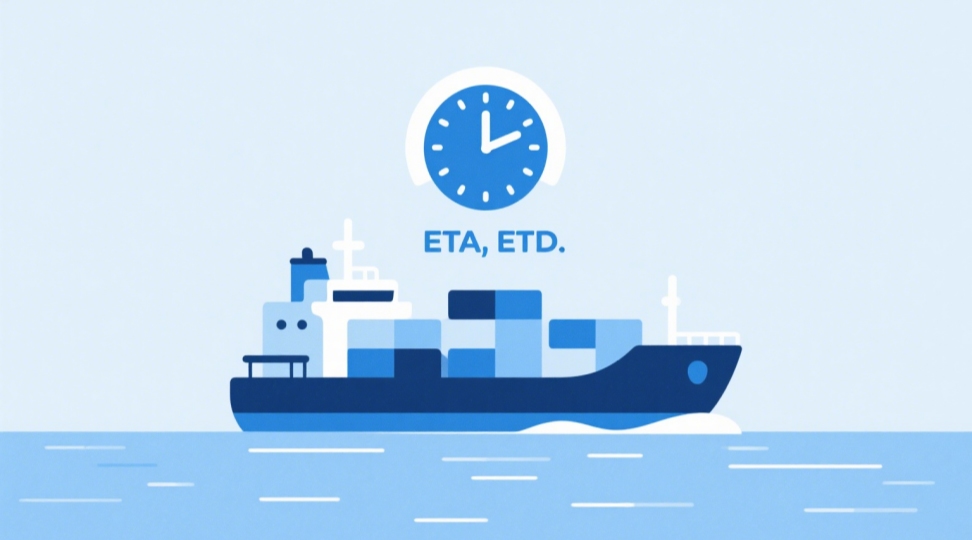¿Qué significan ETA, ETD, ATA y ATD en términos de comercio internacional?
Estas siglas de cuatro letras son la base de los cronogramas de envíos globales. En logística internacional, los transportistas y agentes de carga utilizan ETA, ETD, ATA y ATD para rastrear el cronograma de una carga. En pocas palabras,
- Hora estimada de llegada (ETA) es el Hora estimada de llegada en el destino.
- ETD es el Hora estimada de salida desde el origen.
- ATA es el Hora real de llegada.
- ATD es el Hora real de salida.
Comprender estos términos ayuda a los importadores y exportadores a planificar sus cadenas de suministro. De hecho, el significado de ETA en los negocios va más allá del envío; a menudo se utiliza para describir el tiempo estimado de finalización de un artículo o una entrega. Cuando las empresas comprenden claramente ETA, ETD, ATA y ATD, pueden desarrollar planes realistas, evitar retrasos innecesarios y mejorar la eficiencia general. En DR Trans, ponemos en práctica este conocimiento proporcionando a nuestros clientes actualizaciones transparentes de ETA y ETD, ayudándoles a afrontar los desafíos del envío y a garantizar operaciones logísticas fluidas.
ETA: Hora estimada de llegada
Hora estimada de llegada (ETA) se refiere a la Hora prevista de llegada De un envío a su puerto o ubicación de destino. Es la fecha y hora previstas en que la carga llegará a su destino, según la información actual. Los transportistas calculan el tiempo estimado de llegada (ETA) considerando factores como la distancia, la velocidad, el clima y los posibles retrasos en el puerto. Por ejemplo:
Si un barco sale de Shanghái el 1 de junio, los planificadores podrían establecer una hora estimada de llegada (ETA) para el 15 de junio. Transporte marítimo de Shanghái a Róterdam;Las autoridades portuarias se preparan entonces para esa llegada.
Conocer el tiempo estimado de llegada (ETA) del envío (o la Significado de ETA en los negocios, que es similar) es crucial para programar la descarga, el despacho de aduanas y la entrega final. Una ETA precisa ayuda a las empresas a:
- planificar el trabajo
- gestionar el inventario
- mejorar la satisfacción del cliente

En entornos corporativos, ETA todavía significa “tiempo estimado de llegada” y juega un papel clave a la hora de cumplir con las fechas de entrega y los plazos del proyecto.
ETA en el contexto corporativo y logístico
Ya sea que envíe productos electrónicos o planifique la fecha límite de un proyecto, el tiempo estimado de llegada (ETA) implica la misma idea: es una estimación informada de cuándo llegará un producto. En logística y gestión de la cadena de suministro, un ETA fiable es un indicador clave de rendimiento. ETA significa Hora Estimada de Llegada y es crucial para la logística y la gestión de la cadena de suministro.Las empresas dependen de los tiempos de llegada estimados (ETA) para programar operaciones, mitigar riesgos y mantener satisfechos a los clientes.
Por ejemplo:
- Un tiempo estimado de llegada (ETA) a tiempo permite que un equipo del almacén se prepare para recibir el inventario.
- Si bien una ETA temprana o tardía puede desencadenar planes de contingencia.
En pocas palabras, comprender el significado de ETA en los negocios implica utilizarlo como una herramienta práctica para mejorar la coordinación y reducir demoras.
ETD: Hora estimada de salida
ETD es el Hora estimada de salida, la fecha y hora previstas para que un buque o carga salga de su puerto o instalación de origen. En otras palabras, Significado de ETD Indica cuándo se espera que finalice la carga y el envío comienza su viaje.
Por ejemplo:
Si un transportista reserva un barco para salir de Hamburgo el 10 de septiembre, esa fecha/hora constituye la ETD. Una ETD clara ayuda a todas las partes (transportistas, camioneros y puertos) a planificar adecuadamente.
Unas ETD precisas mantienen la cadena de suministro funcionando sin problemas. Si una ETD se retrasa, la ETA también se retrasará, lo que afectará los cronogramas posteriores. Idealmente, Hora real de salida (ATD) Se ajustará lo más posible a la ETD; mantener la ATD cerca de la ETD ayuda a optimizar toda la cadena de suministro. En la práctica, DR Trans rastrea la ETD de cada envío e informa a los clientes sobre la salida real una vez finalizada la carga.
Ejemplo: Cronograma de envío
Las herramientas de seguimiento modernas suelen mostrar la ETD y la ETA en un mapa interactivo. Por ejemplo, un sistema podría mostrar ATD 24 de abril de 2023 02:30 Desde Shanghái y una versión actualizada “Fecha estimada de llegada: 18 de mayo de 2023, 19:00” en Mumbai (Puerto JN) en un mapa de rutas (ejemplo arriba).
Esta visualización ayuda a los planificadores a ver rápidamente cuándo zarpó un barco y cuándo se espera que llegue. Si el barco sufre un retraso durante el tránsito, el tiempo estimado de llegada se ajustará y se resaltará en el mapa.

ETA, ETD, ATD y ATA son métricas de tiempo que ahorran recursos, ya que definen claramente el progreso del envío. En otras palabras, el seguimiento de estos tiempos permite a los equipos de logística identificar rápidamente retrasos y ajustar los planes.
ATA: Hora real de llegada
ATA significa Hora real de llegada, es decir, el momento exacto en que un envío llega a su destino. En la práctica, el ATA se registra cuando el barco atraca, el avión aterriza o el camión llega a la terminal de entrega.
Puede diferir de la ETA: por ejemplo, si la ETA de un barco era el 15 de junio pero en realidad llega el 17 de junio, la ATA es el 17 de junio.
Por lo tanto, el tiempo estimado de llegada (ETA) es la hora real de llegada. Monitorear el tiempo estimado de llegada (ETA) es importante, ya que una diferencia significativa entre ambos suele indicar problemas como congestión o retrasos en los puertos.
De hecho, la estrecha alineación de la hora estimada de llegada (ETA) y la hora estimada de llegada (ATA) minimiza la pérdida de tiempo: conocer la hora de llegada real con precisión permite a los puertos asignar atracaderos y camiones de manera eficiente. (Los lectores curiosos a menudo preguntan: ¿Qué significa ATA? - Es Hora real de llegada.)
ATD: Hora real de salida
ATD significa Hora real de salidaLa fecha y hora reales en que la carga sale del origen. Tras la carga, la salida exacta se registra como ATD. Si una salida se retrasa más allá de la ETD, la ATD se retrasará y la cadena de suministro se retrasará.
Por ejemplo:
Si un barco está programado (ETD) para partir el 1 de julio pero en realidad no parte hasta el 3 de julio, el ATD es el 3 de julio.
Muchas guías de logística enfatizan que el ATD debe ser lo más cercano posible al ETD para mantener los cronogramas según lo previsto. En resumen, Significado de ATD es simplemente la hora de salida registrada.

En DR Trans, monitoreamos el ATD y el ETA juntos: si el ATD se retrasa, comunicamos de inmediato el impacto en el ETA para ayudarlo a mantenerse a la vanguardia de las demoras.
Comparación rápida
| Término | Forma completa | Definición / Contexto |
|---|
| Hora estimada de llegada (ETA) | Hora estimada de llegada | La hora prevista de llegada al destino. Indica a los planificadores cuándo debería llegar el envío a su puerto o instalación final. |
| ETD | Hora estimada de salida | Hora prevista de salida desde el origen. Indica cuándo saldrá la carga del puerto de carga o almacén. |
| ATA | Hora real de llegada | La hora de llegada real registrada. Muestra cuándo llegó realmente el envío y se utiliza para actualizar los horarios. |
| ATD | Hora real de salida | La hora de salida real registrada. Muestra cuándo el envío salió realmente del origen, indicando si la salida se realizó según lo previsto. |
Cómo estos términos mejoran su proceso de envío
El uso adecuado de ETA, ETD, ATA y ATD marca una diferencia real en la logística:
Mejor coordinación: Conocer la ETD y la ETA permite a los equipos programar recogidas, entregas y almacenamiento con antelación. Por ejemplo, un puerto puede planificar el uso de grúas y mano de obra al conocer la ventana de llegada de un barco.
Congestión reducida: La sincronización precisa ayuda a los puertos y terminales a asignar atracaderos y camiones de forma eficiente, reduciendo los tiempos de espera y los costes. Como señala Oden Logistics, los ETA y los ETD permiten a las autoridades portuarias distribuir los recursos eficientemente. reducir los tiempos de espera.
Satisfacción del cliente: Proporcionar tiempos de llegada (ETA) precisos a los clientes genera confianza. Los expedidores y receptores pueden planificar la dotación de personal y el manejo de la carga cuando el ETA es confiable. Proven.co enfatiza que los ETA precisos ayudan a las empresas a planificar mejor, reducir costos y mejorar la satisfacción.
Resiliencia de la cadena de suministro: El monitoreo de ATD/ATA en tiempo real permite una respuesta temprana ante interrupciones (como el clima o retrasos). Por ejemplo, si el ATD de un camión se retrasa, se actualiza el tiempo estimado de llegada (ETA) para que el destinatario pueda reprogramar sus horarios. DR Trans utiliza estas actualizaciones para resolver problemas de transporte rápidamente, ofreciendo métodos de envío más profesionales a sus clientes.
En general, la claridad en los horarios de ETD/ETA y la información real sobre ATD/ATA brindan confianza a transportistas y clientes. Como informa Sinay, cada hora precisa que rastreamos puede reducir la congestión portuaria y ahorrar tiempo y dinero. En la práctica, DR Trans monitorea los plazos de cada envío y notifica a los clientes sobre cualquier cambio, para que puedan tomar decisiones informadas en cada etapa.
Preguntas frecuentes
P: ¿Qué significa ETA y cuál es su significado?
A: ETA significa Hora estimada de llegadaEs el tiempo estimado de llegada de un envío a su destino. Tanto en el transporte marítimo como en los negocios, el tiempo estimado de llegada (ETA) indica a los planificadores cuándo esperar la mercancía o las entregas. Tener un ETA claro permite a todos (desde el personal portuario hasta los compradores) prepararse para la llegada y evitar sorpresas.
P: ¿Qué significa ETD y por qué es importante?
A: ETD significa Hora estimada de salidaIndica cuándo está previsto que la carga salga de su origen (puerto, almacén, etc.). Un ETD correcto es importante porque define todo el cronograma de entrega. Si el ETD se retrasa, la llegada (ETA) se modificará. Mantener una estrecha alineación entre el ETD y el ATA, como señala una fuente, aumenta la eficiencia de la cadena de suministro. En resumen, la planificación con ETD ayuda a evitar retrasos posteriores.
P: ¿Qué significan ATA y ATD?
A: ATA significa Hora real de llegada, el tiempo real en que llega un envío, y ATD significa Hora real de salidaLa hora real de salida del origen. Estos tiempos reales indican si un envío cumplió con su programación (idealmente, AT, D≈ETD y A≈ETA). El seguimiento de ATA/ATD permite a los transportistas y clientes saber con exactitud cuándo se producen los retrasos y ajustar sus planes en consecuencia.
P: ¿Cómo utiliza DR Trans estos términos para ayudar a los clientes?
A: En DR TransMonitoreamos el tiempo estimado de llegada (ETD) y la hora estimada de llegada (ETA) de cada envío e informamos a nuestros clientes sobre el tiempo estimado de llegada (ATD) y la hora estimada de llegada (ATA) reales durante el trayecto. Al mantener la transparencia en los plazos y utilizar las herramientas de seguimiento más modernas, solucionamos los problemas de envío con anticipación. Este enfoque nos permite ofrecer soluciones de envío más profesionales y confiables, garantizando un transporte fluido de su carga desde el origen hasta el destino.

















 IPv6 RED SOPORTADA
IPv6 RED SOPORTADA
